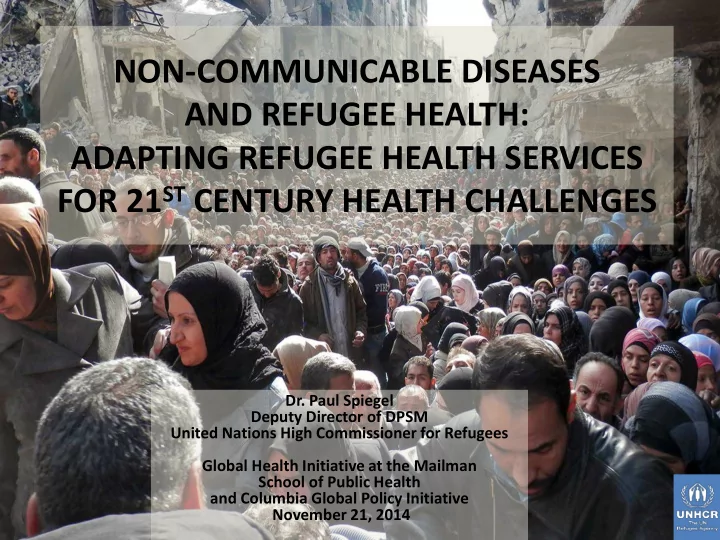

NON-COMMUNICABLE DISEASES AND REFUGEE HEALTH: ADAPTING REFUGEE HEALTH SERVICES FOR 21 ST CENTURY HEALTH CHALLENGES Dr. Paul Spiegel Deputy Director of DPSM United Nations High Commissioner for Refugees Global Health Initiative at the Mailman School of Public Health and Columbia Global Policy Initiative November 21, 2014
Outline of Presentation • Syria situation update • Methods and data • Lessons learned • Recommendations
Current Syrian Situation
Current Syrian Situation cont
Data from Health Info Systems (HIS), 2013 N= 694,280
Health Access and Utilisation Surveys (HAUS) • March 3-10, 2014 • 500 households from sample frame of 130,629 registered households using simple random sampling strategy
HAUS cont
Hospitalization in Jordan Hospital type of most Reason for Selecting recent hospitalization Hospital Affordable cost 42% NGO 7% Emergency 24% Referred by… 14% Private Close to place… 10% 23% Public Like… 4% 70% Other 3% Not aware of… 2% Islamic Charity 0% • Cross-sectional household survey of Syrian refugees living outside camps • Total sample of 1,500 households; 125 clusters x 12 households • Clusters assigned proportionally to sub-districts based using UNHCR registered refugee population
Syrian Refugee Health Access Survey, Jordan Sep 2014 cont % hholds with >1 NCD Household monthly spending Cardiovasc- 160 148 142 ular Disease 140 12% Jordanian Dinars 120 100 80 Hypertension Chronic 60 47 27% 35 Respiratory 40 19 19 16 16 14 12 11 Disease, 14% 20 0 Diabetes, Arthritis, 16% 20% Total monthly spending = 478 JD / month
Cancer
Lessons Learned 1. Integration into and improvement of existing systems 2. Clear and communicated priorities – PHC and Emergency care > secondary/tertiary care 3. Access to (incl cost of) services – Transport, consultation, investigation, meds 4. Understanding which services used by whom and why to direct interventions – Trad’l, pharmacy, public, private, NGO
Lessons Learned cont 5. New systems to deal with new environment Exceptional Care Committee – Private companies (e.g. Lebanon) – 6. Innovative financing mechanisms Health insurance – Cash-based interventions – New actors (e.g. Gulf states) –
Exceptional Care Committee (ECC)
Lessons Learned cont 5. New systems to deal with new environment Exceptional Care Committee – Private companies (e.g. Lebanon) – 6. Innovative financing mechanisms Health insurance – New actors (e.g. Gulf states) – Cash-based interventions –
UNHCR’s Cash Programme- Model for Evidence-Based Targeting in Jordan • 170,000+ assessments underpin decision making system • Reached >25,000 Syrian cases • 8,000 cases on waiting list • Can scale and respond rapidly contingent on funding • Next step is expansion to camps
Recommendations 1. Develop more guidance and dissemination into practice in field 2. Need strategies to deal with reduced funding for Syrian situation now (and for 2015) 3. Adapt Syrian experience to future context- specific crises 4. Move towards unconditional cash Transformational –
Policies and Guidance
Policies and Guidance cont
Recommendations cont 1. Develop more guidance and dissemination into practice in field 2. Need strategies to deal with reduced funding for Syrian situation now (and for 2015) 3. Adapt Syrian experience to future context- specific crises 4. Move towards unconditional cash Transformational with huge implications –
Recommendations cont 5. Continue to utilise technologies to map and address NCDs 6. Need for countries to: Implement public health/ disease prevention – programmes e.g. lifestyle, cancer screening Develop diagnosis and treatment algorithms for – NCDs 7. Dream big! Global health insurance for refugees – Automatic bank account when registered with biometrics –
NCD Project in 4 countries* Expected Outcomes • Development of adapted screening and clinical management tools • Roll out of tailor-made training for medical doctors and clinical officers • Development of community- based management, care and follow-up model for persons with NCDs *Jordan, Burkina Faso, Iraq, Kenya 22
Final Recommendation DREAM BIG! • Global health insurance for refugees • Automatic bank account when registered with biometrics
Recommend
More recommend